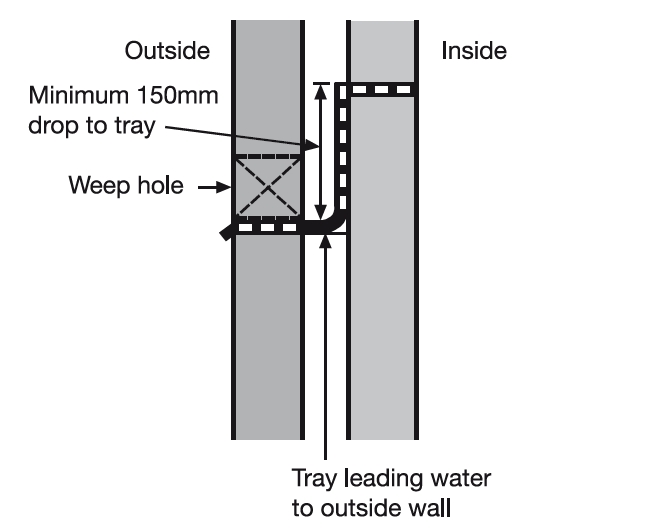Weep hole
Contents |
[edit] Introduction
Brick and stone are porous materials and can absorb and store water. The inclusion of weep holes in masonry walls is intended to serve two purposes:
- Drainage: They provide an opening that allows the drainage of any moisture that may reach the back of a wall, or the inside leaf of a wall (such as a cavity in cavity wall construction) from the outside through penetration, capillary action, condensation, leakage or flooding.
- Ventilation: They allow ventilating air to the back of a wall to help prevent mildew, dry rot and damp which might otherwise reduce the life or performance of building materials such as cavity wall-ties, cavity insulation and so on.
The Masonry Design Manual describes weep holes as, ‘Openings placed in mortar joints of facing materials at the level of flashing, to permit the escape of moisture, or openings in retaining walls to permit water to escape.’
Weep holes are typically found in the outer masonry leaf of cavity walls, just above the flashing. They can also be found above windows, doors or other penetrations. They should be provided at regular intervals so as to allow any moisture collected by cavity trays to escape. The recommended distance between weep holes is 450mm.
[edit] Types of weep holes
[edit] Open head joints
These are formed by omitting mortar from the vertical joint between bricks. Holes are created that are the same size as the typical joint spacing. The spacing between open head joints is typically done at 24 inch (61cm) intervals. They may include plastic weep vents which incorporate a baffle structure to prevent rain from penetrating through the hole and preventing insects from entering the cavity. They may also include a drip at the front lip to aid drainage.
[edit] Cotton rope wicking
A rope of up to 12 inches (30cm) in length is placed in the joints and the other end is extended up into the cavity wall. The moisture inside the wall is absorbed by the cotton and wicked to the outside where is evaporates. This process is slower than with ordinary weep holes.
[edit] Tubes
Tubes made of hollow plastic or metal can be used as weep holes, spaced around 16 inches (41cm) apart. They are placed at a slight angle to allow water egress. Care must be taken to ensure the angle is not too steep or too flat.
Alternatively, oiled rods or ropes can be placed and mortared into the joints. The oil prevents mortar bond and the rods or ropes are removed after setting which leaves a hole similar to that of a tube. The advantage of these techniques is that they are less conspicuous.
[edit] Problems with Weep Holes
[edit] Pest entry
Weep holes can provide access to the wall cavity for unwanted pests such as rodents and insects. Penetrations such as down lights, extractor fans and holes for plumbing or electronics then serve as an internal entry point. Baffled vents can help prevent this problem.
[edit] Trash mortar
As mortar is squeezed out from between successive courses of brick, droppings can fall behind the wall and build up. This can result in weep holes becoming partially, or totally, blocked by trash mortar. Mortar collection devices can be installed to try and alleviate this problem.
[edit] Obstruction of air flow
Measures to try and combat the problems above, as well as make weep holes more aesthetically pleasing, can result in them not providing the necessary flow of air to properly ventilate the internal brick wall.
[edit] Related articles on Designing Buildings Wiki
- Airbrick.
- Building damp-free cavity walls.
- Cavity wall insulation.
- Cavity tray.
- Damp proof course.
- Flashing.
- Lintel.
- Masonry.
- Perpend.
- Rainscreen.
- Wall tie failure.
- Wall types.
[edit] External references
- BPGWI – EA Weep holes
- Masonry Construction – Installing weep holes
Featured articles and news
RTPI leader to become new CIOB Chief Executive Officer
Dr Victoria Hills MRTPI, FICE to take over after Caroline Gumble’s departure.
Social and affordable housing, a long term plan for delivery
The “Delivering a Decade of Renewal for Social and Affordable Housing” strategy sets out future path.
A change to adoptive architecture
Effects of global weather warming on architectural detailing, material choice and human interaction.
The proposed publicly owned and backed subsidiary of Homes England, to facilitate new homes.
How big is the problem and what can we do to mitigate the effects?
Overheating guidance and tools for building designers
A number of cool guides to help with the heat.
The UK's Modern Industrial Strategy: A 10 year plan
Previous consultation criticism, current key elements and general support with some persisting reservations.
Building Safety Regulator reforms
New roles, new staff and a new fast track service pave the way for a single construction regulator.
Architectural Technologist CPDs and Communications
CIAT CPD… and how you can do it!
Cooling centres and cool spaces
Managing extreme heat in cities by directing the public to places for heat stress relief and water sources.
Winter gardens: A brief history and warm variations
Extending the season with glass in different forms and terms.
Restoring Great Yarmouth's Winter Gardens
Transforming one of the least sustainable constructions imaginable.
Construction Skills Mission Board launch sector drive
Newly formed government and industry collaboration set strategy for recruiting an additional 100,000 construction workers a year.
New Architects Code comes into effect in September 2025
ARB Architects Code of Conduct and Practice available with ongoing consultation regarding guidance.
Welsh Skills Body (Medr) launches ambitious plan
The new skills body brings together funding and regulation of tertiary education and research for the devolved nation.
Paul Gandy FCIOB announced as next CIOB President
Former Tilbury Douglas CEO takes helm.
UK Infrastructure: A 10 Year Strategy. In brief with reactions
With the National Infrastructure and Service Transformation Authority (NISTA).























